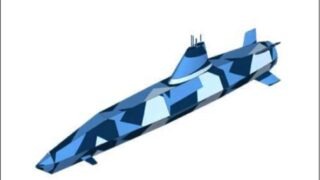As Counterstrike Options
In response to China’s growing military power and North Korea’s nuclear development, Japan has finally acquired its own counterstrike capability under the caveat of “repelling enemy invasion forces.”
To this end, Japan has purchased at least 400 Tomahawk cruise missiles from the US, and is developing “Hyper-Velocity Gliding Projectiles” which are the equivalent to ballistic missiles.
Furthermore, Japan plans to add submarine-launched missiles to their arsenal, effectively giving them the ability to strike the enemy from a concealed position.
The idea is to create new long-range cruise missiles that can be launched from the submarines operated by the Japanese Maritime Self-Defense Force (JMSDF), with the intended targets to be enemy ships as well as ground units.
Needless to say, submarines are more difficult to detect compared to ground-based missiles, thanks to their stealthy nature, raising the level of predicament for China a few notches, to say the least.
By creating a situation where one is uncertain when or where the missiles might be launched, Japan aims to generate anxiety within the enemy, thereby limiting their actions to some degree.
Even if the surface fleet and air-wings suffer huge losses in a preemptive strike, Japan would retain some retaliatory capability as long as their submarines are intact.
While arming Japanese submarines with ground-strike options is a first, they in fact already operate anti-ship missiles including the famous “Harpoon.”
Thus, the goal is to develop a missile capable of both anti-ship and ground-attack missions, with a maximum range of about 1,000km (620 miles).
This will not only allow Japan to strike from beyond the enemy air-defense’s range, but also hit airfields and missile sites on the Chinese mainland, though such intent has not been revealed for obvious reasons.
Combining Two Methods
When it comes to launching submarine-launched missiles, there are two primary methods.
The first is launching it from torpedo tubes, as with the aforementioned Harpoon missile.
This approach will see an encapsulated missile launched underwater, with the capsule being separated and the missile igniting its rocket booster upon reaching the surface.
Since this method requires minimal modifications, it can be launched from existing submarines with ease, making it ideal for early deployment.
As a result, the Japanese government has already signed a contract with Mitsubishi Heavy Industries to develop a long-range cruise missile which will be launched from torpedo tubes.
These will be used against both enemy ships and ground units, with deployment is expected to begin as early as the late 2020s.
 Harpoon launched from torpedo tubes (photo: US Navy)
Harpoon launched from torpedo tubes (photo: US Navy)
Unfortunately, such launch method does come with a downside – the torpedo tubes limiting the size of the missiles.
As the missiles are launched from torpedo tubes, they cannot exceed the diameter of the tubes, which is 533mm in the case of Japanese submarines.
Normally, this would not pose much of a problem, but the recent evolution in range and capacity has seen new missiles grow in size as well.
To accommodate these larger missiles, Japan also plans to install vertical launch systems (VLS) to their existing submarines. These VLS systems enable the submarines to launch missiles that cannot be fired from torpedo tubes, offering a wider range of options.
The prominent candidate for this method is a new model currently under development, which is to be based on the Army’s Type 12 Surface-To-Ship Missile.
Despite such high expectations, the installation of VLS systems would require significant upgrades, resulting in added cost and time.
Therefore, it is unlikely that all JMSDF submarines will have VLS launch cells installed on their hull.
Considering the available time and resources, the most likely scenario is equipping around 1/3 of the fleet with VLS systems whereas the remaining vessels adopt the torpedo launch type missiles.
More Headaches For China
Now, the purpose of submarine-launched missiles is officially stated as “effectively countering enemy vessels and landing forces attempting to invade our country.”
In other words, it is ostensibly intended for striking invasion forces trying to occupy Japanese islands.
But, the maximum range exceeding 1,000 km would naturally suggest its use for striking bases on the Chinese mainland – a legitimate target in a wartime situation.
Nevertheless, whether the target being the enemy fleet, ground forces, or even the missile sites in China, it is unlikely that the submarine-launched missiles would be used as the primary weapon.
Even with missiles boasting a range of over 1,000km, firing them would expose the submarine’s location, thereby sacrificing the advantage of stealthiness.
What is the point of using submarines at all, if you’re going to give away its position to the enemy by launching a salvo of fireworks?
To be clear, this does not mean submarine-launched missiles are ineffective or unworthy weapons.
It’s just that their use as a primary choice of counterstrikes is not really the ideal situation for submarines.
Submarine-launched missiles would be most effective in surprise attacks or hit-and-run tactics, acting as a complementary weapon towards other striking measures.
So, while these missiles mainly serve as deterrence in peacetime, their actual role during wartime would more likely be to supplement the other long range missiles etc.
That being said, the mere fact of arming Japanese submarines with long-range missiles would certainly complicate things for Beijing, adding another headache for sure.
When assuming counterstrikes from the Japanese side, China’s concern was mostly limited to enemy fighter jets or warships, both of which only having limited ground-strike capabilities.
Now, as Japanese fighters and surface vessels, ground units are also being armed with long-range missiles, China has to contend with submarines as well, which are much harder to detect in the first place.
This means that in addition to air defense measures, China must now allocate more resources to anti-submarine operations.




















Comments